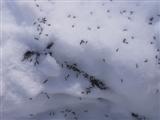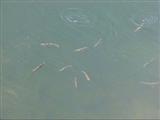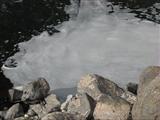River Midge Fishing Tactics - Part 1
This blog is the first of two articles written on fishing river midge hatches during the winter and spring. The second article, focusing on midge patterns, setup, and fishing techniques can be found here.
When I first started winter fly fishing on rivers, I had a preconceived notion that the rivers lacked winter hatches, so any fishing would have to be done with nymphs or streamers presented down deep to lethargic trout. The thought of insects hatching and trout actively feeding at the surface seemed like a distant memory. Surely no self-respecting insect would hatch when it was 20 degrees outside and the wind was howling. Snowy river banks, iced-up rod eyelets, numb fingers and frozen feet were the name of the game now.
I was surprised when I was introduced to midges and winter midge fishing on rivers for trout. In the middle of winter, trout would be rising to tiny bugs on the surface, even when the wind was ripping across the surface. I found that once good holding spots for trout were located, they could consistently be found feeding subsurface on midge pupa and rising to midge adults on a daily basis. On days when the sun was out, the temperature was in the 30s, and the wind was dormant, fishing could be very good indeed.
The spring season only seemed to amplify the good things from the winter: fish were more active due to warmer water temperature; the midge hatches were stronger; and the warmer air temperature made it a little easier to be outside all day. All I needed were successful tactics for catching these active trout.
Midge Lifecycle in Rivers
The first step in successful midge fishing is understanding basic entomology regarding the insect. Midges in rivers and lakes belong to the family Chironomidae and are also known as “Chironomids,” especially to stillwater anglers. The adults look like an adult mosquito, but lack the mosquito’s proboscis; thus, midges cannot bite. Midges undergo a complete metamorphosis, meaning they grow from an egg, to a larva, to a pupa, and finally to an adult.
Midge larvae are worm-like in appearance with no visible legs. While the slender, segmented larvae can be nearly any color, common colors are red, black, olive, and gray. The larvae are bottom-dwelling insects, often either living in tubes they build in silt and mud or living in silk-lined cases they attach to the river bottom. Midge larvae are important to trout (and subsequently anglers) because of what is known as behavioral drift. On a daily basis, the larvae abandon their protective cases and drift with the river’s currents to a new location to find food. It is during this time that they are vulnerable to trout. For midge larvae, behavioral drift is highest at dawn and dusk.
Midge pupae retain the slender, segmented abdomen of their larval stage, but have large thoraxes and white gills at both their head and their bottom. They are fully-formed adult midges inside of their pupal shucks. Once ready to hatch, the midge pupae slowly swim and float to the water’s surface, and are subject to predation the entire journey. The common pupae colors are similar to the common larvae colors: red, black, olive, and gray.
Once at the surface, midge pupae struggle to break through the water’s rubbery meniscus. The surface tension traps the pupae momentarily. Once through, the adults hatch onto the water’s surface. During a hatch, trout key in on this stage of the emerging midge because of its vulnerability.
The adult midge has two wings, long legs, and a long, slender abdomen. Adults can form mating clusters on the water’s surface.
Finding Fish
In the winter, river flows are typically low and slow. Trout congregate in areas where they can minimize expended energy, find safety from predators, and still opportunistically feed. Two ideal places that meet these requirements are pools and deep back eddies. Shallow riffles will also hold trout; the broken water surface affords trout protection and the currents supply trout with food. With each of these water types, the lower water flows allow (and sometimes require) sight fishing to individual fish. Stealthy approaches and presentations may be necessary to successfully fool trout under these conditions.
Pools
Pools will likely hold the majority of trout in the winter time. The slow, deep water keeps the lethargic trout safe. A slight current through the pool can act as a conveyor belt of food to the trout, allowing them to feed while expending minimal energy. When trout are feeding on emerging midges and midge adults, they can hold very close to the surface, even in full sun.
Back Eddies
Back eddies are places along the river bank where the current flows back upstream along the bank. Trout will sit close to the bank and actually face downstream into the current. The back eddy will collect midge adults, crippled midges, or emerging midges on the surface; trout will sip these casually or swim side to side eating midge larvae and pupae in the water column. Not all back eddies will hold trout, however. If the back eddy is shallow, it needs to be connected to a deeper main channel to provide trout with an escape route should a predator appear. Optimal back eddies are those that are at least 2 feet deep and have a deep trough towards the middle of the river for the trout to retreat to.
Foam
With both pools and back eddies, a layer of foam floating on the water can provide trout with an added sense of security from aerial attackers. If you find a pool with foam collecting on top, watch the pool and wait for breaks or shifts in the foam to reveal any feeding trout sitting just under the water’s surface. The foam will also capture midge adults and emerging midges, affording trout an easy, inescapable meal. Look for little dimples or trout noses poking through the foam as a sign of feeding trout.
Shallow Riffles
Shallow, slow riffles offer trout an excellent feeding location for ascending midge pupae and emerging midge adults. The rippled water surface allows trout to sit in surprisingly shallow water while remaining relatively hidden. Optimum shallow riffles are those that feed into a deeper pool or run, or those that have a deeper main channel where trout can flee to when scared. When feeding, trout will not necessarily hold to the bottom of the river in these riffles because the current is not that strong. To spot fish, look to likely areas and stare at the river bottom for some time. Use polarized glasses to reduce the surface glare, focus on the bottom of the river, and wait for the active trout’s movements to reveal the fish’s location. The white of an open mouth, a dark silhouette parallel to the water current, or the silver flash of the fish’s side are all signs of a fish.
In Part 2: Midge Fishing Tactics, Tips, and Patterns
Comments
clinchriverangler12
i am new to fly fishing and dont really kno when to throw flies in there most productive time of the year.what is the best time to fish a midge larva.
Jason Hansen
For river fishing, midge larva patterns are most productive during the winter and early spring months. Few other insects are hatching at this time, so trout really key in on midges.





